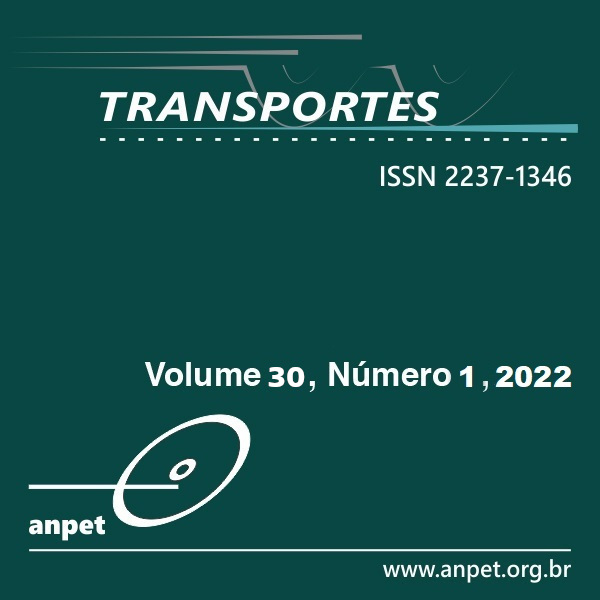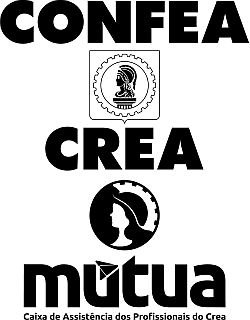Modelagem probabilística do tempo de resposta de motoristas em interseções semaforizadas no VISSIM
DOI:
https://doi.org/10.14295/transportes.v30i1.2501Palavras-chave:
Tempo de reação, Microssimulação, Atraso veicular, Capacidade de interseçõesResumo
O principal objetivo deste trabalho foi implementar, no microssimulador VISSIM, um modelo probabilístico para o tempo de resposta dos motoristas de uma aproximação semaforizada e avaliar os efeitos dessa modelagem no desempenho do tráfego. A partir de dados de uma interseção semaforizada localizada na cidade de Fortaleza foram realizadas análises estatísticas do tempo de resposta por posição do veículo na fila, por faixa de tráfego, por tipo de veículo e por movimento. Essas análises embasaram a modelagem do tempo de resposta pela distribuição de probabilidade encontrada, a log-normal, a qual foi implementada no VISSIM por meio de algoritmo externo de programação desenvolvido em Python. Para avaliar a importância dessa implementação, foram comparados os resultados de atraso médio, de tamanho de fila médio e de capacidade com os resultados das simulações realizadas com a modelagem default do VISSIM. As simulações realizadas com o modelo probabilístico do tempo de resposta resultaram em maiores atrasos e tamanhos de fila e em menores capacidades do que as obtidas com a modelagem default do software.
Downloads
Referências
Basak, K.; S. N. Hetu; Z. Li; C. Azevedo; H. Loganathan; T. Toledo; R. Xu; Yan Xu; L-S. Peh e M. Ben-AkivaA. (2013) Modeling Reaction Time within a Traffic Simulation Model. In 16th International IEEE Conference on Intelligent Transportation Sys-tem, p. 302-309. DOI: 10.1109/ITSC.2013.6728249
Bonneson, J. A. (1992) Modeling queued driver behavior at signalized junctions. Transportation Research Record: Journal of the Transportation Research Board, v. 1365, p. 99-107. Disponível em: <http://onlinepubs.trb.org/Onlinepubs/trr/1992/1365/1365.pdf#page=103> (acesso em 30/11/2021).
Çaliskanelli, P. e S. Tanyel (2018) Investigating the driver’s response time at signalized intersections. Transport, v. 33(2), p. 380-388. DOI: 10.3846/16484142.2016.1250106
Colella, D. A. T. (2008) Comportamento dos motoristas em interseções semaforizadas. Dissertação (mestrado). Departamento de Transportes. Escola de Engenharia de São Carlos, Universidade de São Paulo. São Carlos, SP, Brasil. DOI: 10.11606/D.18.2008.tde-07042008-085004
Horrey, W. J. e C. D. Wickens (2006) Examining the impact of cell phone conversations on driving using meta-analytic tech-niques. Human Factors, v. 48, n. 1, p. 196-205. DOI: 10.1518/001872006776412135
Johnson, R. e D. W. Wichern (2018) Applied multivariate statistical analysis (6ª ed.), p. 187. Pearson.
Koppa, R. (2001). Human Factors. In Gartner, N.; C. J. Messer e A. K. Rathi. Traffic flow theory – A state-of-the-art-report, p. 3-3. Disponível em: <https://www.fhwa.dot.gov/publications/research/operations/tft/chap3.pdf> (acesso em 30/11/2021)
Li, H. e P. D. Prevedouros (2002) Detailed observations of saturation headways and start-up lost time. Transportation Re-search Record: Journal of the Transportation Research Board, v. 1802, p. 44-53. DOI: 10.3141/1802-06
Li, Z.; J. Zhang; J. Rong; J. Ma e Z. Guo (2014) Measurement and comparative analysis of driver’s perception reaction time to green phase at the intersections with and without a countdown timer. Transportation Research Part F: Traffic Psychology and Behaviour, v. 22, n. 0, p. 50-62. DOI: 10.1016/j.trf.2013.10.012
Lin, M.; H. C. Lucas Jr. e G. Shmueli (2013) Too big to fail: Large samples and the p-value problem. Information Systems Re-search, Articles in advance, p. 1-12. DOI: 10.1287/isre.2013.0480
PTV (2020) VISSIM 2020 Manual do Usuário. Karlsruhe, Germany: Plannung Transport Verkehr AG.
Downloads
Publicado
Como Citar
Edição
Seção
Licença
Copyright (c) 2022 Diego Barbosa Fontes, Alessandro Macedo de Araújo, Manoel Mendonça de Castro Neto

Este trabalho está licenciado sob uma licença Creative Commons Attribution 4.0 International License.
Ao submeter um manuscrito para publicação neste periódico, todos os seus autores concordam, antecipada e irrestritamente, com os seguintes termos:
- Os autores mantém os direitos autorais e concedem à Transportes o direito de primeira publicação do manuscrito, sem nenhum ônus financeiro, e abrem mão de qualquer outra remuneração pela sua publicação pela ANPET.
- Ao ser publicado pela Transportes, o manuscrito fica automaticamente licenciado sob a Licença Creative Commons CC BY 4.0. Esta licença permite o seu compartilhamento com reconhecimento da autoria e da publicação inicial neste periódico.
- Os autores têm autorização para assumir contratos adicionais separadamente, para distribuição não exclusiva da versão do trabalho publicada neste periódico (por ex.: publicar em repositório institucional ou como capítulo de livro), com reconhecimento da publicação inicial na Transportes, desde que tal contrato não implique num endosso do conteúdo do manuscrito ou do novo veículo pela ANPET.
- Os autores têm permissão e são estimulados a publicar e distribuir seu manuscrito online (por ex.: em repositórios institucionais ou na sua página pessoal) depois de concluído o processo editorial. Como a Transportes é de acesso livre, os autores são estimulados a usar links para o DOI do artigo nesses casos.
- Os autores garantem que obtiveram todas as permissões necessárias dos empregadores para a publicação e o licenciamento CC BY 4.0 do manuscrito, especialmente se o empregador possuir alguma reivindicação sobre os direitos autorais do manuscrito. Os autores assumem total responsabilidade por questões de direitos autorais relacionadas ao empregador, isentando a ANPET e a Transportes de qualquer responsabilidade relacionada.
- Os autores assumem toda responsabilidade sobre o conteúdo do manuscrito, incluindo as devidas e necessárias autorizações para divulgação de dados coletados e resultados obtidos, isentando a ANPET e a Transportes de toda e qualquer responsabilidade neste sentido.
Última atualização: 27/11/2025











